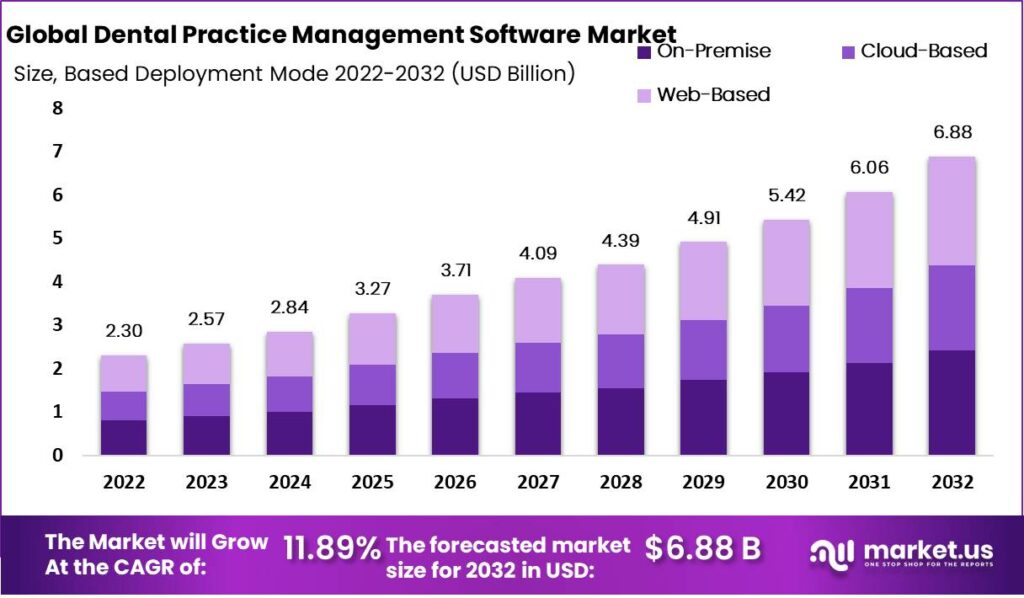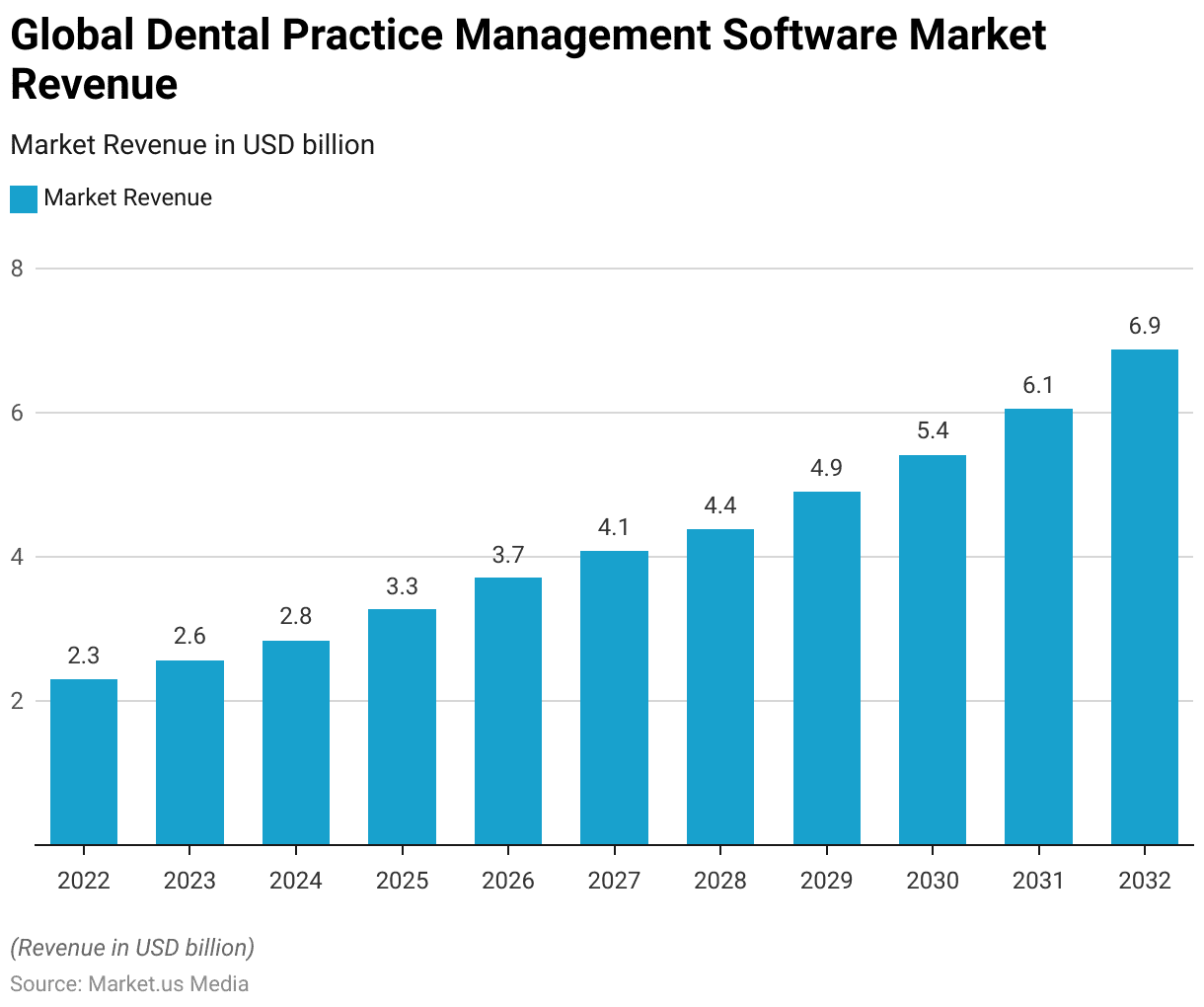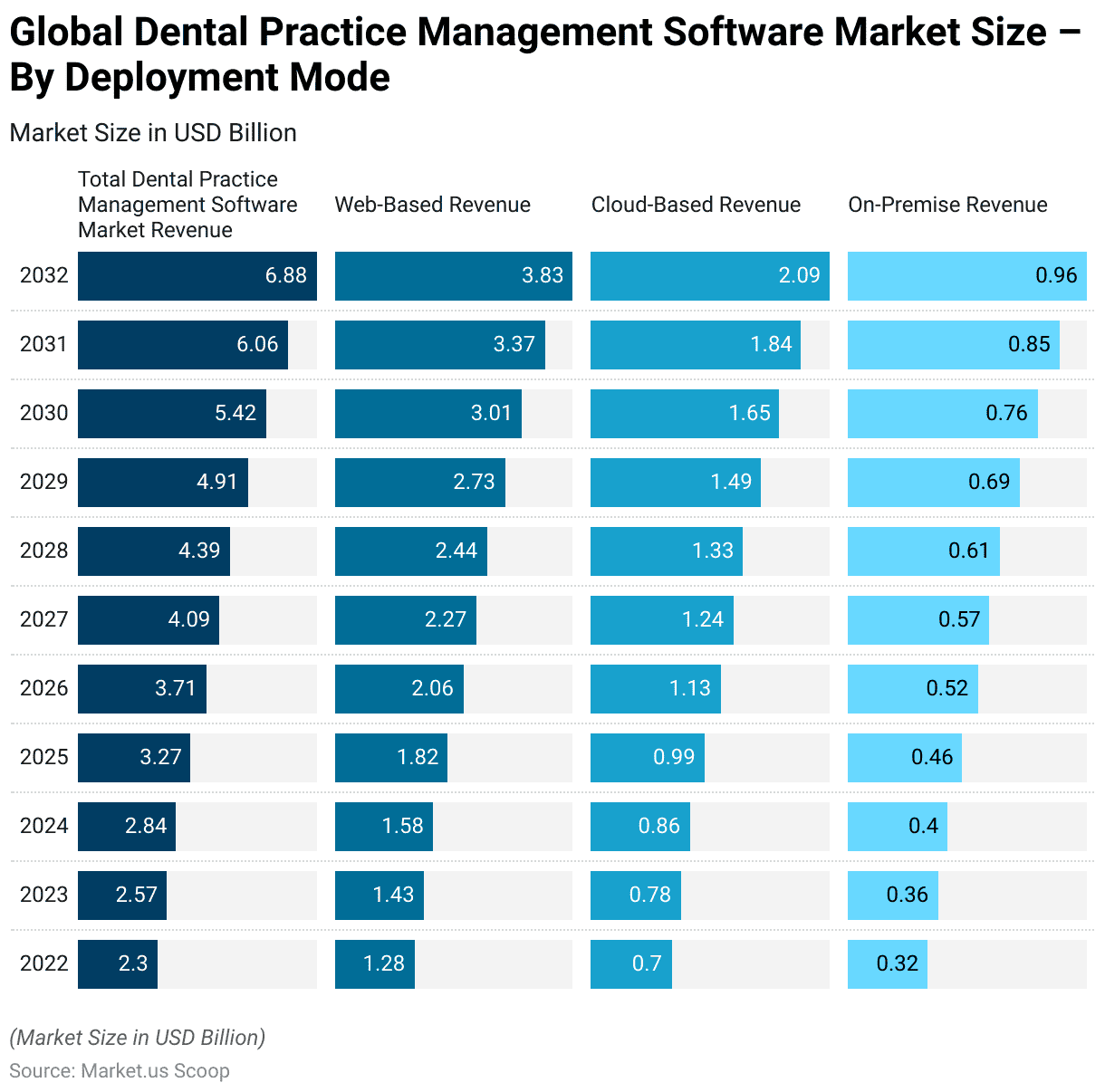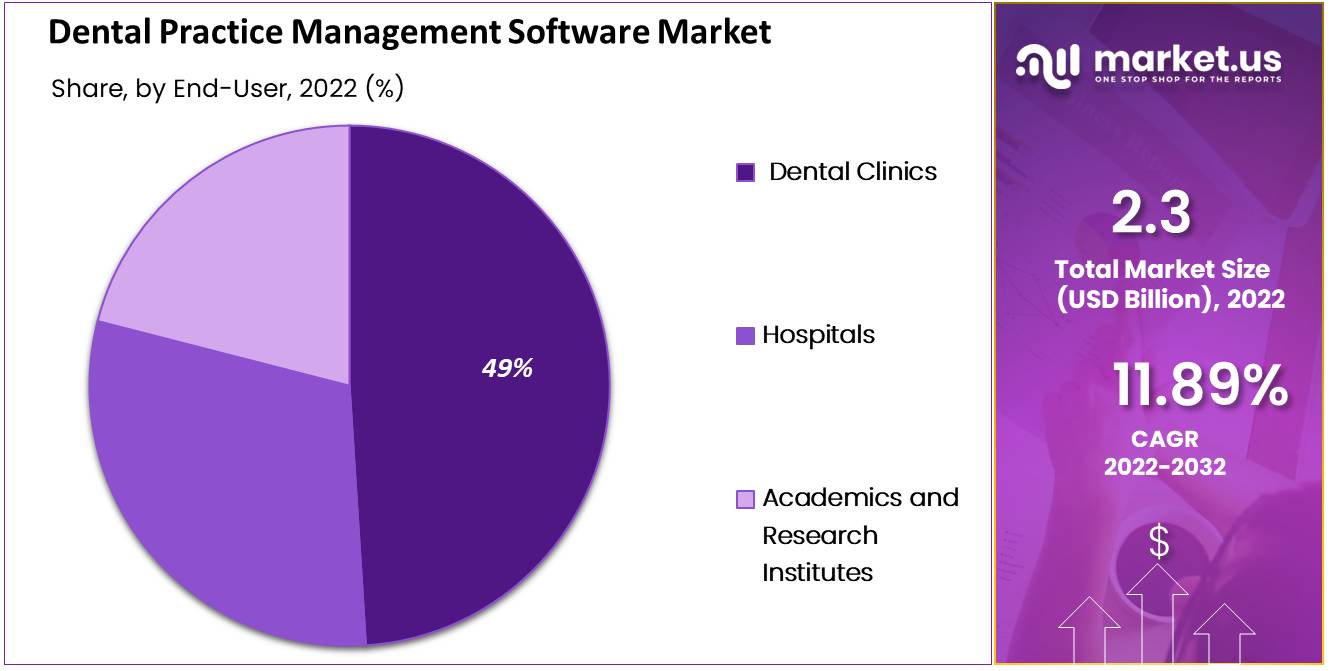Table of Contents
- Introduction
- Editor’s Choice
- Global Dental Practice Management Software Market Overview
- Dental Disorders Driving the Demand for Dental Practice Management Software
- Information Management Systems and Software in Dental Practice
- Patient Satisfaction Statistics
- Patient Perception during COVID-19
- Dental Software Cost
- Critical Trends in Dental Practice Management Software
Introduction
According to Dental Practice Management Software Statistics, Dental practice management software (DPMS) is a comprehensive tool to simplify administrative tasks and enhance operational efficiency within dental practices.
It assists in handling patient records, scheduling appointments, managing billing processes, and documenting clinical procedures. DPMS automates billing functions, facilitates appointment scheduling, and enables digital recording of dental treatments.
Moreover, it includes features for electronic health records (EHR) to store patient data securely. Additionally, DPMS supports inventory management, provides reporting functionalities for analyzing practice performance, and ensures adherence to regulatory standards such as HIPAA.
With user training and support, DPMS helps dental professionals optimize workflows and deliver high-quality patient care.
Editor’s Choice
- The global revenue of the Dental Practice Management Software (DPMS) market reached USD 2.57 billion in 2023.
- By 2032, the total market revenue will reach USD 6.88 billion. Among the deployment modes, web-based solutions are anticipated to dominate the market, with revenues progressively rising from USD 1.28 billion in 2022 to USD 3.83 billion in 2032.
- Dental clinics emerge as the predominant end-user among end-users, holding a significant market share of 49%.
- According to the WHO Global Oral Health Status Report of 2022, approximately 3.5 billion people worldwide suffer from oral diseases, with three-quarters of those affected residing in middle-income countries.
- A 2017 online survey of 1,000 consumers aged 18-64 found that a significant majority, comprising 80% of respondents, expressed a strong inclination towards engaging with companies that provided personalized experiences.
- Software licenses for imaging brands can vary in price, reaching an average of $4,000, depending on the specific brand.
- In the United States and Europe, approximately 80% of dental practices employ dental practice management software (DPMS).

Global Dental Practice Management Software Market Overview
Global Dental Practice Management Software Market Size
- The global revenue of the Dental Practice Management Software (DPMS) market has steadily increased over the years at a CAGR of 11.89%.
- In 2022, it amounted to USD 2.30 billion and gradually rose to USD 2.57 billion in 2023.
- This growth trend continued in 2024, reaching USD 2.84 billion, and is projected to further increase to USD 3.27 billion in 2025.
- The market is expected to maintain its upward trajectory, reaching USD 3.71 billion in 2026 and USD 4.09 billion in 2027.
- By 2028, the revenue is forecasted to reach USD 4.39 billion, followed by USD 4.91 billion in 2029.
- As we move into the next decade, the DPMS market is anticipated to witness significant growth, with projected revenues of USD 5.42 billion in 2030, USD 6.06 billion in 2031, and USD 6.88 billion in 2032.
- This steady expansion reflects the increasing adoption of DPMS solutions worldwide, driven by the growing demand for efficient dental practice management tools and the digitalization of healthcare systems.

Dental Practice Management Software Market Size – By Deployment Mode
- The global dental practice management software market, segmented by deployment mode, demonstrates a consistent upward trend in revenue across all categories.
- In 2022, the total market revenue amounted to USD 2.30 billion, with web-based solutions generating USD 1.28 billion, cloud-based solutions contributing USD 0.70 billion, and on-premise solutions accounting for USD 0.32 billion.
- Over the subsequent years, from 2023 to 2032, there is a notable increase in revenue for all deployment modes.
- By 2032, the total market revenue will reach USD 6.88 billion. Among the deployment modes, web-based solutions are anticipated to dominate the market, with revenues progressively rising from USD 1.28 billion in 2022 to USD 3.83 billion in 2032.
- Cloud-based solutions also show significant growth, from USD 0.70 billion in 2022 to USD 2.09 billion in 2032. On the other hand, on-premise solutions experience comparatively slower growth, with revenues increasing from USD 0.32 billion in 2022 to USD 0.96 billion in 2032.
- This growth trajectory reflects the increasing preference for web-based and cloud-based deployment models, driven by their scalability, accessibility, and cost-effectiveness, in line with the ongoing digital transformation in the healthcare industry.

Global Dental Practice Management Software Market Share – By End-user
- The global dental practice management software market comprises diverse end-user segments, each contributing to its landscape.
- Among these, dental clinics emerge as the predominant end-user, holding a significant market share of 49%. Their adoption of practice management software solutions underscores the importance of efficient patient management, appointment scheduling, and record-keeping within the dental care sector.
- Hospitals, accounting for 30% of the market share, are following closely behind, indicating their recognition of the benefits of streamlined administrative processes and enhanced patient care facilitated by such software.
- Academics and research institutes constitute a noteworthy segment, commanding a 21% market share. Their dental practice management software utilization underscores the importance of organized data management and research facilitation within educational and research settings.
- Together, these end-users shape the dynamics of the dental practice management software market, reflecting a landscape driven by the pursuit of operational efficiency, patient satisfaction, and academic advancement.

Dental Disorders Driving the Demand for Dental Practice Management Software
- According to the WHO Global Oral Health Status Report of 2022, approximately 3.5 billion people worldwide suffer from oral diseases, with three-quarters of those affected residing in middle-income countries.
- Among the global population, around 2 billion individuals have permanent tooth decay, while 514 million children experience decay in their primary teeth.
- The prevalence of complete tooth loss is nearly 7% among individuals aged 20 and above, rising to 23% among those aged 60 and older. Tooth loss can have significant psychological, social, and functional consequences.
- Oral cancer, encompassing cancers of the lip, mouth, and oropharynx, ranks as the 13th most common cancer globally, with an estimated 377,713 new cases and 177,757 deaths in 2020.
- Oral cancer is more prevalent in men, particularly among older individuals, and is associated with socio-economic disparities.
- Oro-dental trauma, resulting from injuries to the teeth, mouth, and oral cavity, affects approximately 1 billion people, with a prevalence of around 20% among children up to 12 years old.
Information Management Systems and Software in Dental Practice
- In dental practices, significant clinical and administrative information is stored using various methods, including paper-based, computer-based, or a combination.
- Computer-based storage is the most prevalent method across most information types, with percentages ranging from 36% to 62%. This indicates a firm reliance on digital systems for managing clinical and administrative data.
- Paper-based storage is still utilized to a significant extent, particularly for dental history (43%), extra-oral examination (47%), and oral health status (45%).
- However, computer-based storage is more widely preferred for information such as alerts and treatment plans.
- Additionally, a small percentage of practices utilize a combination of paper and computer-based methods for storing information, particularly for family dental history and prognosis.
- Overall, the data illustrates the shift towards digitalization in dental practice management, with computer-based storage methods increasingly favored for efficiency and accessibility.
Patient Satisfaction Statistics
- A 2017 online survey of 1,000 consumers aged 18-64 found that a significant majority, comprising 80% of respondents, expressed a strong inclination towards engaging with companies that provided personalized experiences.
- Moreover, 90% of the participants found the concept of personalization appealing.
- When considering the importance of responsiveness to follow-up inquiries via email or phone outside of scheduled appointments, 58% of individuals from the Gen Z, Millennials, and Gen X demographics agreed that such responsiveness significantly contributed to their overall satisfaction.
- This highlights the growing demand for personalized interactions and prompt communication channels among consumers of different ages.
- It underscores the importance for businesses to prioritize personalized customer experiences and maintain responsive communication channels to enhance overall customer satisfaction and foster brand loyalty.
Patient Perception during COVID-19
- As per a study conducted by the CareQuest Institute for Oral Health, the overwhelming % of patients, totaling 86%, expressed satisfaction with their overall teledentistry encounter.
- 50% of Americans believe that the primary factor influencing their decision to visit their dentist amid the pandemic is being aware of any reported cases of COVID-19 within the dental office.
- In a July 2020 North American Dental Group survey, 71% of respondents expressed reluctance to visit their dentists for non-urgent dental procedures amid the pandemic.
- Additionally, 54% indicated that they would only feel comfortable visiting the dentist in the event of a dental emergency.
- A February 2021 report published by the ADA revealed that 90% of patients either had returned to or were prepared to return to their dentist.
Dental Software Cost
Site/User License Fees
- Software licenses for imaging brands can vary in price, reaching an average of $4,000, depending on the specific brand.
- It’s crucial to note that this cost covers only the primary software license, with additional workstations incurring separate fees.
Initial Set-Up Expenses
- Suppliers provide data conversion services priced based on the size of the data. Costs vary from $995 for more straightforward format changes to around $1,295 for more complex transformations on larger data sets.
- Additionally, some software brands may include or offer a TWAIN driver for $1,500 extra, aiding in capturing images from hardware to image management software.
- Data bridging, essential for exchanging information between a PMS and imaging application, may be included or purchasable for up to $2,000.
Training and Ongoing Support
- Although remote training is becoming more common, on-site training remains an alternative.
- Many practices find success with approximately four hours of training. Based on this timeframe and an average rate of $100 per hour for remote training, online training typically costs around $400.
- Conversely, on-site training is usually priced per day, costing an average of $2,500.
Servers and Associated IT Costs
- The cost breakdown for server-related expenses includes hardware acquisition, with servers typically ranging from $5,000 to $6,000.
- Additionally, annual IT and server maintenance expenses total $3,600, covering essential upkeep and support services.
- Off-site backup and data security, crucial for safeguarding sensitive information, incur an annual cost of $2,400.
- These combined expenses are essential investments for maintaining reliable and secure server infrastructure, ensuring smooth operations and data protection for businesses.
Critical Trends in Dental Practice Management Software
- In the United States and Europe, approximately 80% of dental practices employ dental practice management software (DPMS).
- Among these practices, around 70% have noticed a rise in patient appointments and overall revenue.
- The utilization of dental practice management software has led to a reduction of approximately 50% in administrative tasks.
- Patients’ experiences with practices using DPMS are reported as more favorable by approximately 85%.
- Moreover, an estimated 95% of dental practices have seen enhancements in their billing processes by implementing DPMS.
Discuss your needs with our analyst
Please share your requirements with more details so our analyst can check if they can solve your problem(s)



